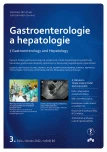Combination of water immersion and carbon dioxide insufflation reduces discomfort associated with colonoscopy
Authors:
Přemysl Falt 1; M. Liberda 1; V. Šmajstrla 1; M. Kliment 1; A. Bártková 1; J. Tvrdík 2; P. Fojtík 1; O. Urban 1
Authors‘ workplace:
Centrum péče o zažívací trakt, Vítkovická nemocnice a. s., Ostrava, 2Přírodovědecká fakulta, Ostravská univerzita, Ostrava, 3Lékařská fakulta, Ostravská univerzita, Ostrava
1
Published in:
Gastroent Hepatol 2012; 66(3): 175-182
Category:
Digestive Endoscopy: Original Article
Overview
Design:
Water immersion insertion and carbon dioxide (CO2) insufflation as alternative colonoscopy techniques are able to reduce patient discomfort during and after the procedure. We assessed whether the combination of water immersion and CO2 insufflation is superior in efficacy and patient comfort to other colonoscopy techniques.
Methods:
In a prospective study, a total of 420 patients were randomized to either water immersion insertion and CO2 insufflation during withdrawal (Water/CO2), water immersion insertion and air insufflation during withdrawal (Water/Air), CO2 insufflation during both insertion and withdrawal (CO2/CO2), or air insufflation during both insertion and withdrawal (Air/Air). The main objective pursued was the success of minimal sedation colonoscopy which was defined as reaching the caecum without switching to another insertion method and without additional sedation beyond the initial 2 mg of midazolam. In addition, patient comfort during and after the procedure was assessed.
Results:
A total of 404 subjects were analyzed. The success rate of minimal sedation colonoscopy in the water insertion arm (Water/CO2 and Water/Air) was 97% compared with 83.3% in the gas insertion arm (CO2/CO2 and Air/Air) (p < 0.0001). Intraprocedural pain and bloating were significantly lower in the Water/CO2 group than in all other groups. Patient discomfort in the Water/CO2 group during the 24 hours after the procedure was comparable with CO2/CO2 and significantly lower than in the air groups (Water/Air and Air/Air). There were no complications recorded in the study.
Conclusion:
A combination of water immersion and CO2 insufflation appears to be an effective and safe method for minimal sedation colonoscopy. Overall patient discomfort was significantly reduced compared with other techniques.
Key words:
colonoscopy – water immersion – carbon dioxide insufflation
Sources
1. Early DS, Saifuddin T, Johnson JC et al. Patient attitudes toward undergoing colonoscopy without sedation. Am J Gastroenterol 1999; 94(7): 1862–1865.
2. Subramanian S, Liangpunsakul S, Rex DF. Preprocedure patient values regarding sedation for colonoscopy. J Clin Gastroenterol 2005; 39(6): 516–519.
3. Romagnuolo J, Cotton PB, Eisen G et al. Identifying and reporting risk factors for adverse events in endoscopy. Part I: cardiopulmonary events. Gastrointest Endosc 2011; 73(3): 579–585.
4. Leung FW, Leung JW, Mann SK et al. The water method significantly enhances patient-centered outcomes in sedated and unsedated colonoscopy. Endoscopy 2011; 43(9): 816–821.
5. Leung FW, Leung JW, Mann SK et al. DDW 2011 cutting edge colonoscopy techniques – state of the art lecture master vlase – warm water infusion/CO₂ insufflation for colonoscopy. J Interv Gastroenterol 2011; 1(2): 78–82.
6. Delon ES, Hawk JS, Grimm IS et al. The use of carbon dioxide for insufflation during GI endoscopy: a systematic review. Gastrointest Endosc 2009; 69(4): 843–849.
7. Kim LS, Koch J, Yee J et al. Comparison of patients´ experiences during imaging tests of the colon. Gastrointest Endosc 2001; 54(1): 67–74.
8. Falchuk ZM, Griffin PH. A technique to facilitate colonoscopy in areas of severe diverticular disease [letter]. New Engl J Med 1984; 310(9): 598.
9. Leung JW, Salera R, Toomsen L et al. Pilot feasibility study of the method of water infusion without air insufflation in sedated colonoscopy. Dig Dis Sci 2009; 54(9): 1997–2001.
10. Leung CW, Kaltenbach T, Soetikno R et al. Water immersion versus standard colonoscopy insertion technique: randomized trial show promise for minimal sedation. Endoscopy 2010; 42(7): 557–563.
11. Leung JW, Mann SK, Siao-Salera R et al. A randomized, controlled trial to confirm the beneficial effects of the water method on U. S. veterans undergoing colonoscopy with the option of on-demand sedation. Gastrointest Endosc 2011; 73(1): 103–110.
12. Leung FW, Harker JO, Jackson G et al. A proof-of-principle, prospective, randomized, controlled trial demonstrating improved outcomes in scheduled unsedated colonoscopy by the water method. Gastrointest Endosc 2010; 72(4): 693–700.
13. Radaelli F, Paggi S, Amato A et al. Warm water infusion versus air insufflation for unsedated colonoscopy: a randomized, controlled trial. Gastrointest Endosc 2010; 72(4): 701–709.
14. Leung FW, Leung JW, Siao-Salera RM et al. The water method significantly enhances detection of diminutive lesions (adenoma and hyperplastic polyp combined) in the proximal colon in screening colonoscopy - data derived from two RCT in US veterans. J Interv Gastroenterol 2011; 1: 48–52.
15. Rogers BH. The safety of carbon dioxide insufflation during colonoscopic electrosurgical polypectomy. Gastrointest Endosc 1974; 20(3): 114–117.
16. Stevenson GW, Wilson JA, Wilkinson J. Pain following colonoscopy: elimination with carbon dioxide. Gastrointest Endosc 1992; 38(5): 564–567.
17. Sumanac K, Zealley I, Fox BM. Minimizing postcolonoscopy abdominal pain by using CO(2) insufflation: a prospective, randomized, double blind, controlled trial evaluating a new commercially available CO(2) delivery system. Gastrointest Endosc 2002; 56(2): 190–194.
18. Bretthauer M, Lynge AB, Thiis-Evensen E et al. Carbon dioxide insufflation in colonoscopy: safe and effective in sedated patients. Endoscopy 2005; 37(8): 706–709.
19. Geyer M, Guller U, Beglinger C. Carbon dioxide insufflation in routine colonoscopy is safe and more comfortable: results of a randomized controlled double--blinded trial. Diagn Ther Endosc 2011; 2011: 378906.
20. Maple JT, Keswani RN, Hovis RM et al. Carbon dioxide insufflation during ERCP for reduction of postprocedure pain: a randomized, double-blind, controlled trial. Gastrointest Endosc 2009; 70(2): 278–283.
21. Hirai F, Beppu T, Nishimura T et al. Carbon dioxide insufflation compared with air insufflation in double balloon enteroscopy: a prospective, randomized, double-blind trial. Gastrointest Endosc 2011; 73(4): 743–749.
Labels
Paediatric gastroenterology Gastroenterology and hepatology SurgeryArticle was published in
Gastroenterology and Hepatology

2012 Issue 3
Most read in this issue
- Moviprep® – a modern bowel cleansing before procedures
- Antibiotic prophylaxis with acute pancreatitis
- Primary sclerosing cholangitis in patients with inflammatory bowel disease
- Combination of water immersion and carbon dioxide insufflation reduces discomfort associated with colonoscopy
